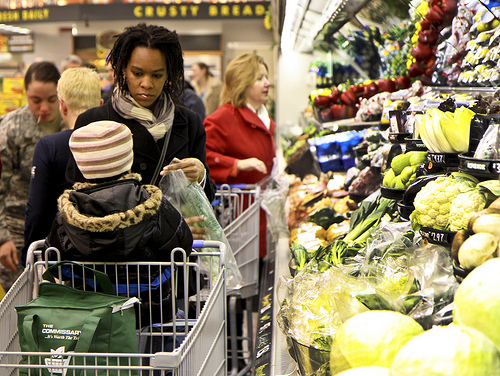
Photo by USACE Europe District.
In a previous post, Ali wrote about her journey from meal challenged mom to coauthor of the book that bridges the sustainable food world with that of real families. The following is an excerpt from chapter 2 of The Cleaner Plate Club, the book she co-wrote with Beth Bader (Storey Publishing, 2011).
First, understand that food marketers have a goal that is the opposite of your own. While you hope to get in and out of the supermarket quickly, with healthful food that didn’t cost very much, food marketers are trying to get you to stay as long as possible and to buy as much as possible, without much regard to whether the items are healthful or not. If you ever hope to get in and out of the supermarket without ruining all hopes for good health, you should understand some of the strategies at work as you shop.
Some of the tactics are sensory, like the bakery-fresh smell that is piped into the store to attract your attention to the doughnuts, or the slow music that encourages shoppers to unconsciously linger in the aisles. Some tactics are about exposure, which is why food companies often pay hefty “slotting fees” for prime real estate, like the towering displays at the end of each aisle and eye-level space on the shelves. Then there is the layout of the store itself, of course — the way staples like milk and eggs are placed in the far rear corner of the store, so that you pass as many products as possible on your way to them, invariably putting some into your cart.
But the marketing strategies also operate at a much deeper level. Long before you stepped into the store, food companies hired sociologists, anthropologists, psychologists, and child development specialists with the sole purpose of identifying the triggers that make you and your children unconsciously reach for certain foods. These triggers involve naming, packaging, image licensing, advertising, and stealth marketing. They are even intended to exploit weaknesses in the parent-child relationship (known within the industry as “pester power”).
“Oh, come on,” you might think, offering up a healthy dose of skepticism. “People are just not that gullible. These strategies can’t possibly work.” Amazingly, study upon study confirms that they do. That’s why 70 percent of shoppers bring lists into supermarkets, but a mere 10 percent stick to them. For every item on the list, shoppers pick up an average of two items they hadn’t planned to buy.
The research clearly indicates that just about everyone — including the “experts” who spend their lives studying these very food marketing strategies — are influenced by food marketing. What’s more remarkable is that nobody ever thinks it works.
Speaking personally, this is one of the reasons we prefer to visit farmers markets instead of supermarkets whenever possible. It’s a relief, we’ve found, not to have to steel ourselves to resist an environment that encourages us to buy, buy, buy. It’s nice not to have fight like David against a billion-dollar marketing Goliath.
However, it’s hardly practical to give up supermarkets altogether. After all, even if you are fortunate enough to be able to buy most of your staples directly from the farmer year-round, chances are you’ll need to stop by a supermarket for laundry detergent or light bulbs, at least once in a while.
Strategies for shopping healthfully and frugally
Shop the pantry at home first. Planning meals around the ingredients you have on hand helps keep the list short, and it also keeps your grocery bill lower than your mortgage payment.
Plan ahead, then stick to your list. Plan your meals in advance. If you begin planning meals while you’re in the grocery store, you’ll probably get overwhelmed. Knowing what you need before you enter the store is critical. But sticking to a list is even more important. It can also help to set a budget before you go, and then to keep a running tally on a calculator as you add items to your cart.
Don’t go hungry. If you enter the supermarket on an empty stomach, you’ll make more impulse purchases.
Never bring children who are hungry or tired. Trust us on this one: It is always a mistake. Fill them up with good food before you arrive. When in doubt, stop by the deli area for some sliced cheese that you can feed to your child as you go.
Stick to the outer aisles. The healthiest items in the store are almost always on the periphery — the produce, dairy, fish, and frozen sections. With few exceptions — dried beans and rice, olive oil, and seasonings among them — the center aisles are filled with highly processed, nutrition-poor alternatives.
Beware of anything making health claims. A health claim emblazoned on a box is, ironically, usually the telltale sign of something you probably don’t want to eat. Fresh broccoli doesn’t brag about its high iron and fiber content, and you’ll never find apples boasting about their calcium levels.
Bulk up. If you’re lucky enough to shop at a store with a bulk aisle, you’ll find delicious, healthful whole-food options, without the extra packaging, at a great price. From quinoa — an amino acid–rich seed that can be cooked like rice — to whole-grain flours, dried beans, and nuts, most bulk products are good for your health, your wallet, and the planet.
Explore the produce aisle. If there’s one place to get adventurous or to make impulsive purchases, it’s the produce aisle. This section is a smorgasbord of health-boosting phytochemicals, vitamins, minerals, fiber, and great tastes.


